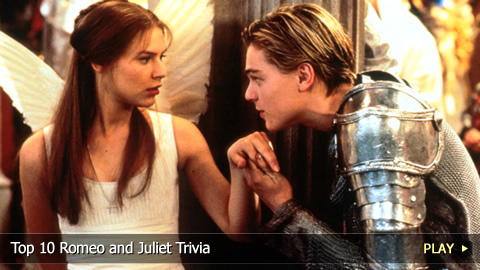Top 10 Romeo and Juliet Trivia

#10 – About the Author
Born in Stratford-upon-Avon, England in the mid-16th century, William Shakespeare went to grammar school as a boy and married Anne Hathaway at age 18. In the late 1500s, he began acting in his own stage plays and those of others. The Bard of Avon also wrote sonnets and poems. His success as a writer allowed him to have a playing company, and they constructed a playhouse called the Globe Theatre. He died in 1616.
#9 – Influences and Inspirations
Tragic romances were popular centuries before Shakespeare’s time, as far back as antiquity. So it’s not surprising that “Romeo and Juliet” became one of his most famous and most performed plays. After Arthur Brooke translated an old Italian novella into an English poem, the Bard made the story his own by adding new characters and subplots and mixing comedic and tragic elements.
#8 – Settings and Era
Shakespeare wrote “Romeo and Juliet” while living in London during the 1590s, which was several years after his theatrical career began. The tragicomedy is set in Italy during the Renaissance period between the 1300 and 1400s. The play’s main action takes place in Verona, though Romeo is also briefly exiled to Mantua.
#7 – Plot
The play follows a young couple named Romeo and Juliet whose families hate each other. After they secretly marry, Tybalt kills Romeo’s friend Mercutio. Romeo takes Tybalt’s life in return but is then exiled. To stop her forced marriage to Count Paris, Juliet takes a drug that makes her look like she died. Romeo drinks poison to join her in death, but this results in Juliet’s suicide and the end of the Montague-Capulet grudge. Though the play’s told mostly from Romeo and Juliet’s points of view, their servants occasionally take over to illuminate their masters’ actions.
#6 – Romeo Montague
The teenaged Romeo’s love for Juliet makes him do anything to be with her despite their families’ fighting. Since he isn’t interested in masculine activities like getting into trouble in the streets, he initially refuses Tybalt’s challenge to a duel. He also doesn’t want to fight those who are now his family through marriage. However, after Tybalt kills Mercutio, Romeo seeks his deadly revenge. His youth and impulsiveness ultimately lead to his and Juliet’s deaths.
#5 – Juliet Capulet
The young and beautiful teenaged Juliet matures very quickly throughout the play. Though her parents want her to marry another, she’s determined to control her own life and choose whom she’ll love and be with. In a very short time, Juliet detaches herself from them and gives her loyalty to her new husband, Romeo. Unfortunately, her sacrifices help cause her and Romeo’s deaths.
#4 – Other Characters: Mercutio and Tybalt
Tybalt is Juliet’s proud, macho and intimidating cousin. He wants to make sure everyone knows he’s a good fighter – and he helps keep the Capulet-Montague feud going with all the hate inside him. As Romeo’s close friend, Mercutio won’t hesitate to offer him advice when he’s feeling down. Since he also feels a strong loyalty to the Montagues, he’s willing to fight Tybalt to the death.
#3 – Values and Themes
Through Shakespeare’s use of epic passionate language, he explores the theme of young love and how it can be beautiful but also lead to tragedy. For despite the Montague-Capulet’s longstanding hate, Romeo and Juliet found love, which plays into notions of fate and chance. The play also tackles loyalty, family, and death, especially with respect to how Romeo and Juliet’s deaths make their families put aside their feud in the interest of peace.
#2 – Modern Popularity
First published in 1597, “Romeo and Juliet” quickly became one of Shakespeare’s most popular plays while he was still alive. Its story helped to introduce romance to the genre of tragedy while its protagonists gave us the ultimate model of two people in love. After having been performed for centuries thereafter, the play continues to fascinate and entertain people today.
#1 – Adaptations
From operas and ballets to musical pieces and works of literature, “Romeo and Juliet” has inspired them all. It’s also arguably the play that’s been adapted for the screen the most. One of the most well known examples from the early 20th century is the Oscar-nominated 1936 film. But the two most critically and commercially successful versions are the Oscar-winning 1968 take and the contemporary 1996 rendition.
Do you agree with our list? What’s your favorite piece of “Romeo and Juliet” trivia? Be sure to subscribe to WatchMojo.com for more entertaining top 10s.
